.
15.03.2013

The SBIRS GEO-2 spacecraft arrives at Cape Canaveral Air Force Station, Fla., in January 2013. Photo Credit: U.S. Air Force
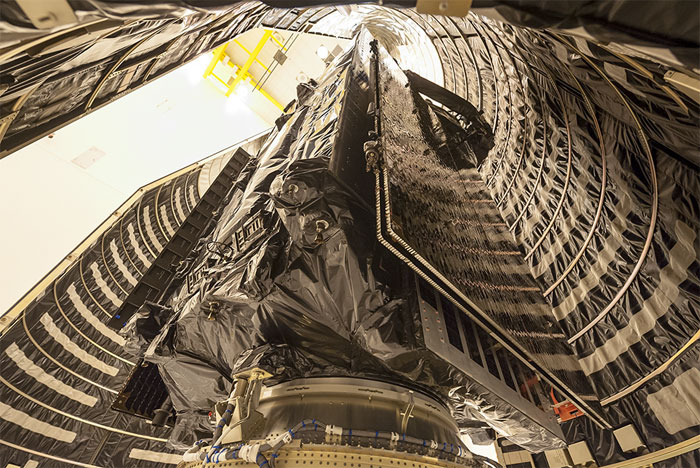
The second Lockheed Martin built Space Based Infrared System (SBIRS) Geosynchronous Earth Orbit (GEO-2) spacecraft was encapsulated into its payload fairing March 4 in preparation for a March 19 liftoff aboard an Atlas V rocket from Cape Canaveral Air Force Station, Fla.
SBIRS GEO-2, the most technologically advanced infrared surveillance satellite, will enhance the nation's missile warning capabilities and simultaneously improve the missile defense, technical intelligence and battlespace awareness mission areas.
The satellite includes highly sophisticated scanning and starring sensors with improved infrared sensitivity and a reduction in area revisit times over the legacy constellation. The scanning sensor will provide a wide area surveillance of missile launches and natural phenomena across the earth, while the staring sensor will be used to observe smaller areas of interest with superior sensitivity.
Featuring a mix of satellites in geosynchronous orbit, hosted payloads in highly elliptical earth (HEO) orbit, and ground hardware and software, the SBIRS program delivers timely, reliable and accurate infrared surveillance information to the President of the United States, the Secretary of Defense, combatant commanders, the intelligence community and other key decision makers.
Lockheed Martin's SBIRS contracts include four HEO payloads, four GEO satellites, and ground assets to receive, process, and disseminate the infrared mission data. The team has also begun procuring long lead parts for the fifth and sixth GEO satellites. HEO payloads and the first GEO satellite have already launched into orbit.
The SBIRS team is led by the Infrared Space Systems Directorate at the U.S. Air Force Space and Missile Systems Center. Lockheed Martin is the SBIRS prime contractor, Northrop Grumman is the payload integrator. Air Force Space Command operates the SBIRS system.
.
Update: 18.03.2013
.
Atlas V to Launch SBIRS GEO-2
Rocket/Payload: An Atlas V 401 will launch Space-Based Infrared System (SBIRS) GEO-2 for the U.S. Air Force
Date/Site/Launch Time: Tuesday, March 19, 2013, from Space Launch Complex (SLC) 41 at Cape Canaveral Air Force Station, Fla. The 40-minute launch window opens at 5:21 p.m. EDT.
Mission Description: SBIRS, considered one of the nation's highest priority space programs, is designed to provide global, persistent, infrared surveillance capabilities to meet 21st century demands in four national security mission areas including: missile warning, missile defense, technical intelligence and battlespace awareness.
Launch Notes: This launch will be the third ULA launch in 2013, the 37th Atlas V mission, and the 69th ULA launch. The SBIRS GEO-1 mission also launched on an Atlas V 401, blasting off from Cape Canaveral Air Force Station on May 7, 2011.
Viewing the Launch by Webcast: A live simulcast of the launch broadcast will begin at 5:01 p.m. EDT.
Quelle: ULA
-
The U.S. Air Force and Lockheed Martin (LMT) are ready to launch the second Space Based Infrared System (SBIRS) Geosynchronous Earth Orbit (GEO-2) spacecraft on Tuesday, March 19 aboard a United Launch Alliance Atlas V rocket from Cape Canaveral Air Force Station, Fla. The launch window is 5:21 EDT to 6:01 p.m. EDT.
A live launch broadcast will begin at 5:01 p.m. EDT and will be accessible via the ULA webcast.
Featuring a mix of satellites in geosynchronous orbit, hosted payloads in highly elliptical earth (HEO) orbit, and ground hardware and software, the SBIRS program delivers resilient and improved missile warning capabilities for the nation while also providing significant contributions to the military's missile defense, technical intelligence and battlespace awareness mission areas.
"We understand the important role SBIRS plays in our national security architecture and the entire SBIRS team has worked tirelessly to prepare this satellite for a successful launch," said Jeff Smith, Lockheed Martin's vice president of Overhead Persistent Infrared (OPIR) mission area. "The dedication and talent of this SBIRS team is remarkable and we are keenly focused on delivering mission success for the warfigher."
Lockheed Martin's SBIRS contracts include four HEO payloads, four GEO satellites, and ground assets to receive, process, and disseminate the infrared mission data. The team has also begun procuring long lead parts for the fifth and sixth GEO satellites. HEO payloads and the first GEO satellite have already launched into orbit.
GEO-1 is meeting or exceeding performance expectations on its path to operational certification. The satellite's sensor pointing accuracy is nine times more precise than required and the sensors are detecting targets 25 percent dimmer than required with an intensity measurement 60 percent more accurate than specification.
The SBIRS team is led by the Infrared Space Systems Directorate at the U.S. Air Force Space and Missile Systems Center. Lockheed Martin is the SBIRS prime contractor, Northrop Grumman is the payload integrator. Air Force Space Command operates the SBIRS system.
Headquartered in Bethesda, Md., Lockheed Martin is a global security and aerospace company that employs about 120,000 people worldwide and is principally engaged in the research, design, development, manufacture, integration, and sustainment of advanced technology systems, products, and services. The Corporation's net sales for 2012 were $47.2 billion.
.
Update: 20.03.2013
Erfolgreicher Start von Atlas-V mit SBIRS-GEO-2 Satelliten / Frams: ULA-Start-Video:
.

.
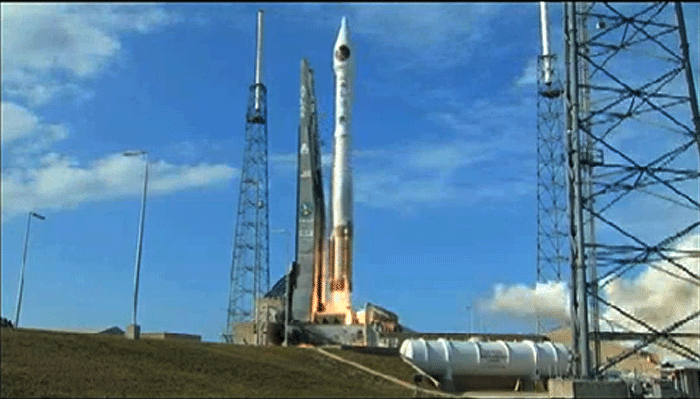
.
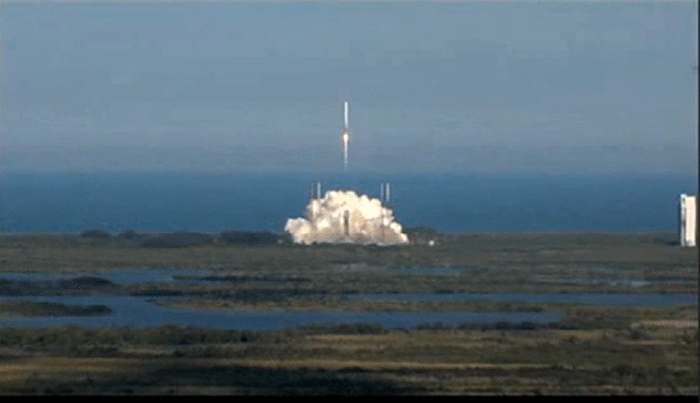
.
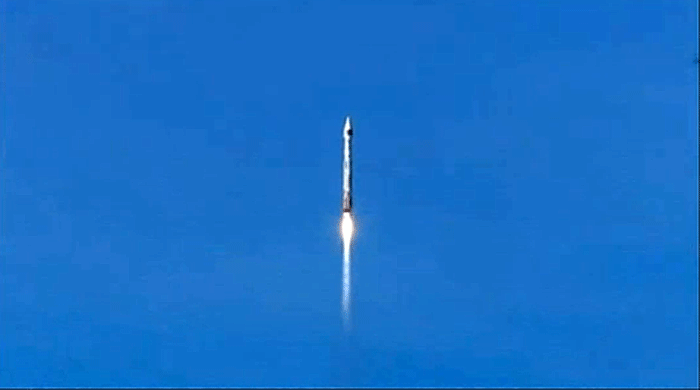
.

.
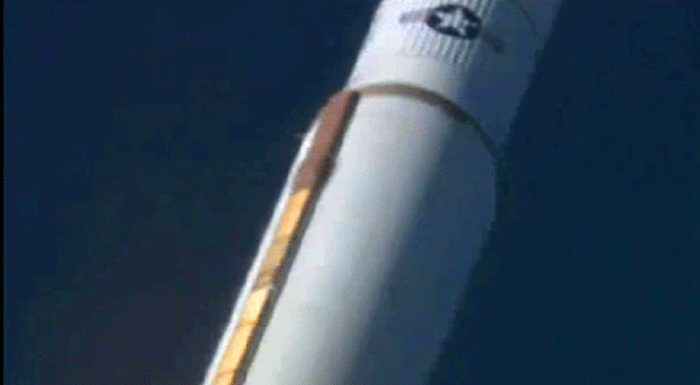
.
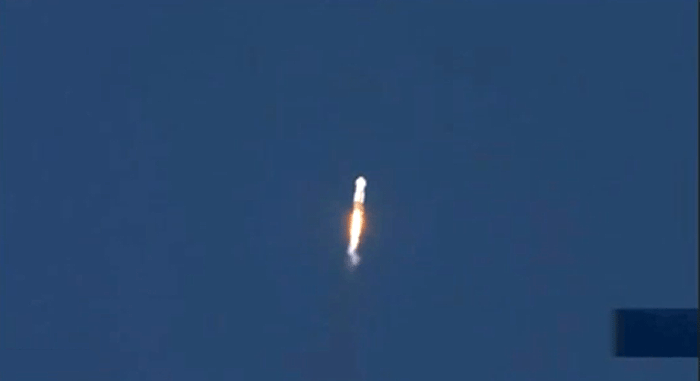
.
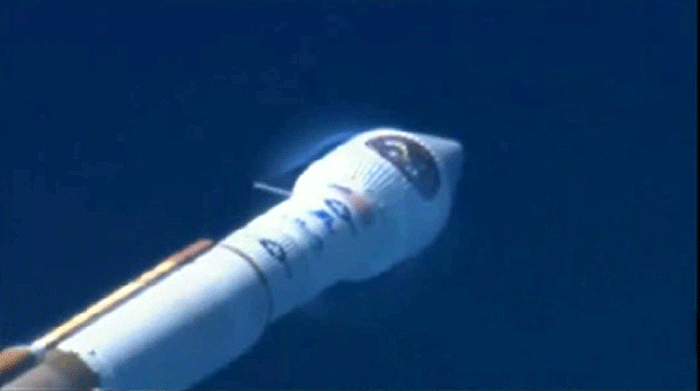
.

.
ULA Atlas V launch with SBIRS GEO-2 successful
.
he United Launch Alliance (ULA) launched their Atlas V rocket Tuesday, carrying the SBIRS GEO-2 infrared missile detection satellite into orbit. Liftoff from SLC-41 at Cape Canaveral was on schedule at 21:21 UTC (16:21 EST), followed by the successful deployment of the spacecraft.
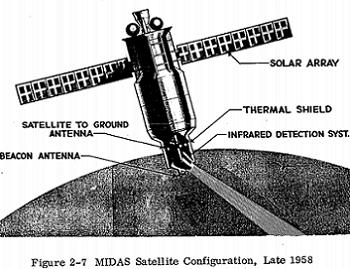
Atlas V Launch:
SBIRS GEO-2 is the second satellite in the Space-Based Infrared System, SBIRS, a US Air Force program to detect ballistic missile launches and provide the United States with advance warning of potential nuclear attacks.
Missile detection spacecraft originated in the days of the Cold War; SBIRS is a third-generation system, following on from the Missile Defense Alarm System and later Defense Support Program.
In the 1950s, the United States developed a series of ground-based radar systems to detect incoming Soviet missiles and bombers, culminating in the Ballistic Missile Early Warning System (BMEWS), which became operational in 1959 and remains in use.
Ground-based systems are limited in range, however, and can only detect missiles when they are already close to their targets. To augment BMEWS, the US Air Force developed the Missile Defense Alarm System, or MIDAS.
MIDAS consisted of a constellation of satellites in low Earth orbit, using infrared sensors to detect missiles from their exhaust emissions. The first satellite was launched in February 1960, however it failed to achieve orbit due to a problem with its Atlas LV-3 Agena-A carrier rocket which occurred during first stage separation. A second satellite was launched three months later, but its communications system failed after less than a day in orbit.
.

The third satellite also operated for less than a day following its July 1961 launch; one of its solar panels failed to deploy, and the satellite quickly ran out of power. The next launch failed; a guidance problem resulted in MIDAS-4 being deployed into an incorrect orbit, and the Agena-B upper stage, which was integrated into the payload, ran out of RCS propellant trying to compensate. MIDAS-5 fared little better, suffering a complete loss of power within hours of launch.
After MIDAS-6 failed to achieve orbit, the seventh satellite was the first to compete a successful mission, detecting launches of American Atlas, Titan, Minuteman and Polaris missiles. MIDAS-8 failed to orbit, and MIDAS-9 was a partial failure, operating for only a few days after its solar arrays failed to deploy, but long enough to test its sensors, and detect both American and Soviet missile tests.
The last three satellites, designated the Research Test Series, were optimized to detect shorter-range missiles, including those launched from submarines.
MIDAS-10 was lost in another launch failure; its upper stage failed to restart leaving it in a useless orbit. MIDAS-11 and 12 were both successful, operating for a year each.
MIDAS-12, launched in October 1965, was the final satellite in the program. MIDAS was never used as an operational system; instead it demonstrated the technology which would later be used by the Defense Support System (DSP).
DSP, which was originally designated the Integrated Missile Early Warning System (IMEWS), was designed to use smaller numbers of satellites in higher orbits, compared to MIDAS.
In 1970 the first satellite, OPS 5960, was launched aboard a Titan III(23)C. Three more Block I DSPs followed. The first-generation satellites were designed to operate for 15 months each. Built by TRW, they had a mass of 900 kilograms (2,000 lb).
Following the fourth launch in 1973, DSP became fully operational. Replenishment launches, with Block II satellites, began in 1975. These satellites were more powerful, and ha nine months longer design life than the Block I.
Three standard Block II satellites were launched, followed by four Multi-Orbit Satellite/Performance Improvement Modification, or MOS/PIM, spacecraft with extra attitude control propellant and more power. The fourth MOS/PIM satellite was launched by a Titan III(34)D/Transtage, following the Titan III(23)C’s retirement with the third launch.
Two spare Block II satellites were retrofitted with sensors designed for the Block III satellites, to serve as a stopgap after Block III was delayed. Block III launches occurred between 1989 and 2007, using a variety of rockets; Three were launched by Titan IV(402)A rockets, five by Titan IV(402), one by Space Shuttle Atlantis with an Inertial Upper Stage during STS-44, and a Delta IV Heavy for the final launch following the Titan IV’s retirement.
Two of the Block III satellites failed. The sixth satellite, launched in April 1999, was lost when the upper and lower stages of the Inertial Upper Stage, which was part of the Titan IV(402)B configuration, failed to separate.
When the upper stage ignited, the satellite was left out of control in an unusable orbit. Despite being unable to complete its mission, the satellite was used until 2008 for research into the Van Allen belts.
The other failure was of the last satellite to be launched, USA-197, which ceased to function after ten months in service. The US Air Force have not released any details on the cause or nature of the malfunction, however following the satellite’s failure the MiTEx satellites visited USA-197 to inspect it and attempt to establish the cause of the anomaly.
SBIRS will replace DSP. SBIRS uses satellites in both geosynchronous and highly elliptical orbits, unlike DSP which used only geostationary spacecraft.
Geosynchronous SBIRS missions, such as GEO-2, use dedicated spacecraft, while highly elliptical orbit missions use sensors hosted on other satellites.
The first launch of the SBIRS program occurred in June 2006, when a Delta IV-M+(4,2) lofted USA-184 into a molniya orbit. USA-184, also designated NRO Launch 22 (NROL-22), is a classified satellite operated by the US National Reconnaissance Office.
USA-184 carries two unclassified secondary payloads; NASA’s TWINS-A, and the first SBIRS-HEO payload. The second was included, along with TWINS-B, on USA-200. Also designated NROL-28, it was launched in March 2008 by an Atlas V 411. Like USA-184, USA-200 is a classified NRO payload.
Amateur observers have identified both spacecraft as being the first two members of a new series of electronic intelligence satellites; successors to the Trumpet satellites launched in the 1990s.
The first dedicated SBIRS satellite, SBIRS GEO-1 or USA-230, was launched by an Atlas V 401 in May 2011. It has still not entered service; following over a year of extended post-launch tests, it entered operational testing in November 2012, however this uncovered a defect in its communications system which has delayed its entry into service.
GEO-2 is currently expected to enter service before it.
A low Earth orbit component of SBIRS, SBIRS-Low, was cancelled, and subsequently became the Space Tracking and Surveillance System (STSS). USA-205, a risk-reduction satellite for the program, was launched in May 2009, followed four months later by two demonstration satellites, USA-208 and 209, which had originally been built for the SBIRS program.
Lockheed Martin constructs SBIRS-GEO satellites, which use the A2100M bus. Their instrumentation is built by Northrop Grumman.
Satellites carry an infrared sensor which provides global coverage, plus a second sensor covering a smaller area at higher resolution. The satellites are procured by the US Air Force through the Infrared Space Systems Directorate. Each satellite has a mass of around four and a half tonnes (10000 lb), and is expected to operate for 12 years.
Tuesday’s launch used an Atlas V carrier rocket, with tail number AV-037, flying in the 401 configuration.
It was the thirty-seventh Atlas V to launch, and the seventeenth to fly in this configuration, which consists of a Common Core Booster (CCB) first stage, a Centaur second stage with a single RL10 engine, a payload fairing with a diameter of four meters, and no solid rocket motors.
To encapsulate SBIRS GEO-2 for launch, the Long Payload Fairing, which despite its name is the shortest of the Atlas V’s three available four-meter fairings, was used.
Launch of AV-037 began with the ignition of the CCB’s RD-180 engine, at T-2.7 seconds. When the countdown reached zero, the engine reached the required thrust for liftoff, when the rocket’s thrust to weight ratio rises above 1, at about T+1.1 seconds.
The rocket climbed vertically for the next 16.6 seconds, before pitching over and beginning a series of roll and yaw manoeuvres to attain the necessary trajectory for its ascent. AV-037 flew east over the Atlantic Ocean, with a flight azimuth of 98.82 degrees. Around 90.6 seconds after liftoff, AV-037 passed through the area of maximum dynamic pressure, or Max-Q.
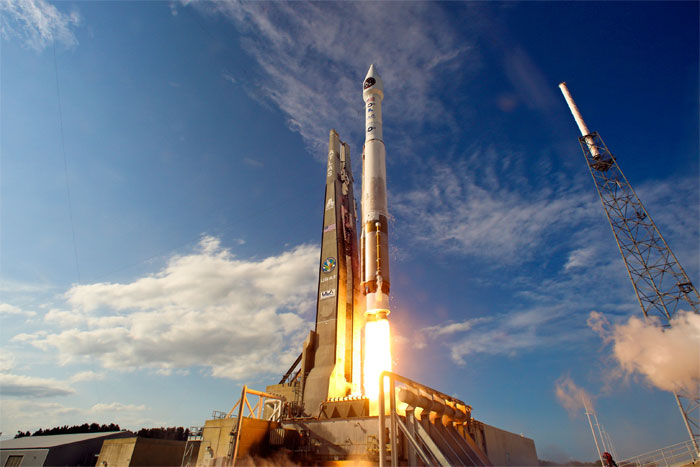
The first stage burned for four minutes and 3.1 seconds, before shutting down; this event is designated Booster Engine Cutoff, or BECO. Six seconds later the first stage was jettisoned, and following another 9.9 seconds of coasting, the Centaur’s RL10A-4-2 engine ignited for its first burn. This burn lasted for 11 minutes and 1.9 seconds. Payload fairing separation came 8.1 seconds after the Centaur ignites.
The mission entered a short coast phase following the end of the first burn. Eight minutes and 46.6 seconds later, the RL10 restarted to place SBIRS GEO-2 into its planned deployment orbit. The second burn lasted three minutes and 55.4 seconds, and shutdown marked the end of powered flight.
Following a second, longer coast phase, lasting 15 minutes and 9.7 seconds, spacecraft separation was successful.
The target orbit for the deployment of SBIRS GEO-2 is one with a perigee of 185 kilometres (100 nautical miles or 115 statute miles), an apogee of 35,786 kilometres (19,322.8 nautical miles or 22,236 statute miles), 22.19 degrees of inclination, and an argument of perigee of 178 degrees. Spacecraft separation will occur over the Indian Ocean, in sight of the Diego Garcia tracking station.
AV-037 was launched from Space Launch Complex 41 at Cape Canaveral. Built as a Titan launch complex in the 1960s, SLC-41 has been used for Titan IIIC, Titan IIIE, Titan IV and Atlas V rockets. Tuesday’s launch is the thirty-first Atlas launch from the complex, and the fifty-eighth overall.
The pad is served by the Vertical Integration Facility, a tower half a kilometre (600 yards) southeast of the launch pad which is used to assemble rockets before they are rolled to the pad for launch. AV-037, atop its mobile launch platform, was transported to the launch pad around 15:00-15:30 UTC (10:00-10:30 EST) on Monday.
Tuesday’s launch marked the twelfth or thirteenth orbital launch attempt of 2013, depending on whether a rumoured yet unconfirmed Iranian launch attempt around 17 February is counted. It was the third Atlas launch of the year, and also the third for ULA, as no Delta IV launches have thus far occurred in 2013.
The Delta IV’s first flight of the year is scheduled for 8 May, with a Wideband Global Satcom communications satellite, and will be ULA’s next launch as things stand. The next Atlas launch is expected to come a week later, with a Global Positioning System navigation satellite; the first GPS satellite to launch on an Atlas since 1985.
The next SBIRS GEO satellite is scheduled to launch in 2015. Launch dates for SBIRS HEO payloads are classified because they fly on NRO satellites; however no known NRO launches in the next two years use a configuration and launch site compatible with the second-generation Trumpet satellites which seem to host them.
.
Quelle: ULA / NASA
.

3/19/2013 - CAPE CANAVERAL AIR FORCE STATION, Fla. -- The U.S. Air Force's 45th Space Wing successfully launched a United Launch Alliance Atlas V rocket carrying the second Space Based Infrared System (SBIRS) GEO-2 satellite into orbit from Space Complex 41 at 5:21 p.m. on March 19.
A combined team of military, government civilians and contractors from across the 45th Space Wing provided support to the mission, including weather forecasts, launch and range operations, security, safety and public affairs.
The launch of SBIRS GEO-2 continues the replacement of the Defense Support Program (DSP) constellation, which has been in operation since 1960. The SBIRS GEO-1 was launched May 7, 2011, also from CCAFS.
"This spacecraft will provide next-generation missile warning, missile defense, and battlespace characterization for the next two to three decades," said Lt. Col. Paul Konyha, 45th Launch Support Squadron commander.
"Once again, the entire team worked hand-in-hand to make this another successful launch for the Air Force and our nation," said Brig. Gen. Anthony Cotton, 45th Space Wing commander. "Our hats go off to them for all their hard work."
.
Quelle: USAF
5937 Views
